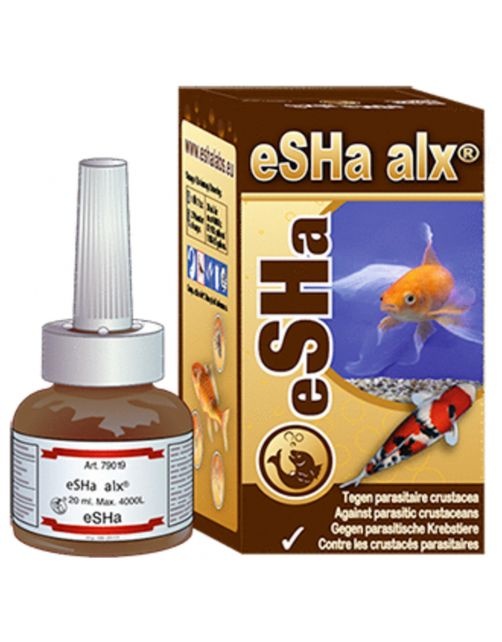eSHA ALX 20 ML
eSHa alx® is a medicine for ornamental fish against parasitic Crustacea species (Maxillipoda) such as Argulus (carp louse), Lernaea (Anchor worm), Ergasilus (gill crayfish), Salmincola (one-eyed crayfish), etc. The parasitic crustacea occur on and in the skin of the fish and on the gills in front. The parasites can often be seen with the naked eye. The symptoms of both parasites are similar: Trying to jump out of the aquarium / pond, rubbing the whole body against stones and bottom, visible places where the parasites have bitten, afterwards it turns white because the skin dies.
Pale gills, listless, skittish reactions, losing weight, separating from the group, stopping eating, etc. For more information see www.eshalabs.eu. Side effects: not known.
Remove Shrimp and Lobsters! eSHa alx is well tolerated by ornamental fish in freshwater aquariums and ponds. Be careful with lower animals such as corals, anemones, sea urchins, snails, shellfish, etc. In the presence of these animals, OR remove them from the aquarium or pond before treatment OR treat the fish in a quarantine tank. Observe the aquarium carefully during the treatment and, if there are any problems, filter directly over activated carbon and then change the water.
1. Carp louse (Argulus): They look like a greenish, transparent, round crustacean with black tips all over the body, they can grow to 8 mm in size and have two suction cups to hold on to and a kind of stinger that they use to catch the fish stiches. The adult carp louse mates on the fish, after mating the female leaves the fish and the female lays +- 300 eggs in the aquarium / pond. After this she dies. Depending on the temperature, the eggs hatch between 10 days and several months. The fry then swim around freely and after a number of moults they look for a host, once the host has been found they grow into an adult carp louse in about two months and are sexually mature. The cycle is therefore strongly dependent on the temperature. Young fish can be killed with 1 sting. 2, 3 & 4 Anchor worms (Lernaea), gill shrimp (Ergasilus) and one-eyed shrimp (Salmincola): Only the female sex is parasitic and uses nutrients and blood obtained from the body of the fish to develop her eggs. The eggs are contained in two egg sacs at the end of the parasite. When the eggs are ripe enough, these bags fall off the fish. The young that hatch from the eggs develop into adults in a free-swimming stage and start looking for a partner. After mating, the female searches for the fish, where the cycle starts all over again. 2. Anchor worms (Lernaea): An anchor worm looks like a long string sticking out of the fish with two 'tails' (the egg sacs). Anchor worms can grow up to 2 cm. They can occur anywhere on the body, but usually on the underside (inferior) of the fish. For example at the base of the caudal fin or between the gills and the lateral fin. 3 & 4. Gill Crayfish (Ergasilus) and One-Eyed Crayfish (Salmincola): The name says it all, these parasites often occur on the gills, but also on the gill cover, on the fins and in the oral cavity. The crustaceans (± 2 mm) can still be seen with the naked eye and can even be clearly seen with a magnifying glass. The fish lose weight, weaken and become listless with pale gills due to anemia.
Day 1: 1 drop per 7 liters of aquarium water. (1 ml per 200 liters of aquarium water). Day 7: 25% water change and floor vacuuming. If not all parasites are gone: Day 14: 1 drop per 7 liters of aquarium water (1 ml per 200 liters of aquarium water). Day 21: 25% water change and vacuuming the bottom













